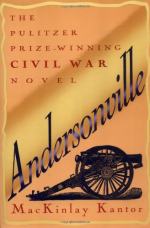There was never any risk in approaching any guard with a proposition of this kind. I never heard of one refusing to trade for greenbacks, and if the men on guard could not be restrained by these stringent laws, what hope could there be of restraining anybody else?
One day we were favored with a visit from the redoubtable General John H. Morgan, next to J. E. B. Stuart the greatest of Rebel cavalry leaders. He had lately escaped from the Ohio Penitentiary. He was invited to Richmond to be made a Major General, and was given a grand ovation by the citizens and civic Government. He came into our building to visit a number of the First Kentucky Cavalry (loyal)—captured at New Philadelphia, East Tennessee—whom he was anxious to have exchanged for men of his own regiment—the First Kentucky Cavalry (Rebel)—who were captured at the same time he was. I happened to get very close to him while he was standing there talking to his old acquaintances, and I made a mental photograph of him, which still retains all its original distinctness. He was a tall, heavy man, with a full, coarse, and somewhat dull face, and lazy, sluggish gray eyes. His long black hair was carefully oiled, and turned under at the ends, as was the custom with the rural beaux some years ago. His face was clean shaved, except a large, sandy goatee. He wore a high silk hat, a black broadcloth coat, Kentucky jeans pantaloons, neatly fitting boots, and no vest. There was nothing remotely suggestive of unusual ability or force of character, and I thought as I studied him that the sting of George D. Prentice’s bon mot about him was in its acrid truth. Said Mr. Prentice:
“Why don’t somebody put a pistol to Basil Duke’s head, and blow John Morgan’s brains out!” [Basil Duke was John Morgan’s right hand man.]
CHAPTER XII.
Remarks as to nomenclature—vaccination and its effects—“N’YAARKER’S” —Their characteristics and their methods of operating.
Before going any further in this narrative it may be well to state that the nomenclature employed is not used in any odious or disparaging sense. It is simply the adoption of the usual terms employed by the soldiers of both sides in speaking to or of each other. We habitually spoke of them and to them, as “Rebels,” and “Johnnies ;” they of and to us, as “Yanks,” and “Yankees.” To have said “Confederates,” “Southerners,” “Secessionists,” or “Federalists,” “Unionists,” “Northerners” or “Nationalists,” would have seemed useless euphemism. The plainer terms suited better, and it was a day when things were more important than names.




